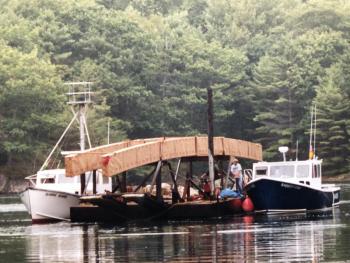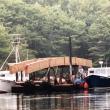Ovens Mouth: A vital link then and now
While the Boothbay Region Land Trust preserves are well known for their scenic beauty, many may not be aware of the rich history behind these captivating properties. In recognition of BRLT’s 40th anniversary, it will be releasing a series of four short films with companion articles highlighting some of its most iconic nature preserves. The series will touch upon the histories, features, uses and environmental significance of each featured property. The first in this series recognizes Ovens Mouth Preserve.
Ovens Mouth has been an important regional landmark on the Boothbay peninsula as far back as historical records have been kept. From pre-colonial Native American accounts through the present day, the unique waterways at Ovens Mouth have provided a vital link for the region’s economic activities, its diverse marine ecosystem, and its outdoor recreation.
The name Ovens Mouth is used to refer to the narrow passage connecting the Sheepscot River to the extensive Cross River tidal basin. The dynamic narrows showcase a massive tidal flow each day where currents can move at over five knots. Ovens Mouth Preserve encompasses two of the three small peninsulas on the south side of these narrows, providing access to over five miles of recreational hiking trails with stunning shoreline views.
Some of the region’s most sustained economic activity has ties to Ovens Mouth. In pre-colonial times, Ovens Mouth was an important shortcut for Native Americans traveling between the Sheepscot and Damariscotta Rivers. Later when European settlers arrived and eventually colonized the region, the water routes including Ovens Mouth formed the major transportation hubs. The land surrounding Ovens Mouth was privatized and converted to pasture for agricultural use. Apple trees found on the preserve are evidence of this agrarian past. In later years, the land was reforested, though it remained working land, and was utilized for timber harvesting well into the 20th century.
Other industries also took advantage of the convenient location to access the waterways and major transportation routes. While Boothbay Harbor has a long and storied history in shipbuilding, one of the region’s earliest shipyards was located in the Ovens Mouth basin. Another emblem of the region’s economic past is Ice House Cove, the cove between the eastern and western peninsulas of Ovens Mouth preserve where the current pedestrian bridge crosses. In 1879, this cove was dammed to prevent the fresh water in the cove from mixing with the tidal water. The ice that formed on this freshwater ice pond was shipped by schooner mainly to Boston and New York during the height of the ice boom. When crossing the pedestrian bridge today visitors can see the remains of the stone and earthen dam. The dam no longer stands and today water flows freely in out of the cove, restoring the land to its natural state as a salt marsh.
In 1994, Boothbay Region Land Trust purchased the 146 acres making up the eastern and western parts of the preserve. At the time, the two peninsulas remained distinct preserves until 1999 when a 93-foot pedestrian footbridge was placed connecting the East and West sides of the preserve and producing the land trust’s most extensive trail system. Installing this bridge was a huge engineering feat requiring beams that were specially shipped to Wiscasset from the Midwest with a police escort. In Wiscasset the beams were loaded onto a barge in the early morning hours. The barge had a custom built frame to hold the beams in position so that they would land on the cement abutments correctly when the tide receded. At high tide a crew lined the barge into position and then waited in anticipation as the tide went out to see if the beams would land correctly. The two beams settled down perfectly onto the abutments. At this point the barge was on the salt marsh side of the dam. The metal support frame was cut off, and as the tide went out the barge just fit under the bridge and floated over the dam—an incredible engineering success! Today the bridge at Ovens Mouth provides one of the best spots for nature observation.
As a nature preserve, Ovens Mouth provides an incredible array of diverse habitats for the region’s marine and terrestrial wildlife. Seabirds rely on the salt marsh for feeding. These intertidal coves also provide important protection to juvenile fish, shrimp, and crabs. And from mud flats to deep-water passages, the area supports a great diversity of key species including lobsters and clams. So while the marine resources continue to support the local economy, the miles of intricate waterways and shoreline trails provide countless recreational opportunities to the public from boating and kayaking to hiking and birding. One thing is certain, Ovens Mouth has always been and remains today an essential landmark that enhances the lives of those who live in and visit the Boothbay region.
Readers are invited to view the companion film and learn more about Ovens Mouth by visiting bbrlt.org/news.
Acknowledgements and thanks to Dawn Kidd and Bob Krist for their support in research and film production.
Event Date
Address
United States




































